Share this link via
Or copy link
One of the best Japanese Kanji dictionary.

If you want to use Kanji to write “kawaii,” it will be「可愛い」. You need to add the Hiragana「い」since it is an adjective. (Adjective in Japanese all ends with「い」.) If it becomes a noun, the shape changes to「可愛さ」(kawaisa).
Writing the word in Hiragana is also accepted.
The characters「可」and「愛」are used just as a phonetic equivalent. The original Japanese pronunciation of「可」is “ka,” and that of 「愛」is “ai.”
However, if you want to refer to the Japanese Kawaii subculture, you should use Katakana「カワイイ」.
Contents
The origin of the word kawaii is「かほはゆし(顔映ゆし)」(  kaohayushi), which is not used today. The abbreviation is「かはゆし」(
kaohayushi), which is not used today. The abbreviation is「かはゆし」(  kawayushi ). It literally means that the person looks so bright that you can’t face him or her, and therefore means “to feel ashamed.” The meaning changed to “you can’t face the person because he or she seems so pitiful” over time. Moreover, the meaning turned into “adorable” in Muromachi period(室町時代, from 1336 to 1573) from the feeling that you want to help someone pitiful.
kawayushi ). It literally means that the person looks so bright that you can’t face him or her, and therefore means “to feel ashamed.” The meaning changed to “you can’t face the person because he or she seems so pitiful” over time. Moreover, the meaning turned into “adorable” in Muromachi period(室町時代, from 1336 to 1573) from the feeling that you want to help someone pitiful.
Kawaii has various meanings and is not a word only for “cute.”
Here are some meanings that are on the latest Japanese Dictionary(国語辞典 kokugo jiten).
Dictionary Cited: Hidetoshi Kenbo et al.,『三省堂国語辞典 第七版』Sanseido Kokuo Jiten Dainanahan, Saiseido, 2014, pp.298
For most of the times, Kawaii could be translated to “dear,” “adorable,” “cute,” “pretty,” “lovely,” “sweet,” “charming,” “darling,” “tiny,” or “little.” But there are some usages like 「誰でも自分がかわいいものだ」(  Daredemo jibun ga kawaii mono da) meaning “Everyone puts himself first.”
Daredemo jibun ga kawaii mono da) meaning “Everyone puts himself first.”
If you ask an ordinary young man in Japan “What kind of girls do you like?”, they will probably answer 「かわいい子」 (Kawaii ko  ). In this context, “Kawaii” is quite close to “pretty” in English, and he is perhaps emphasizing good looks and youth.
). In this context, “Kawaii” is quite close to “pretty” in English, and he is perhaps emphasizing good looks and youth.
Here are some famous sayings using “Kawaii.”
One is 「かわいい子には旅をさせよ」(  Kawaii ko ni wa tabi o saseyo ) .「旅」(tabi) means “travel.” This proverb says, “If you love your children, you should force them to go out and see the world outside.”
Kawaii ko ni wa tabi o saseyo ) .「旅」(tabi) means “travel.” This proverb says, “If you love your children, you should force them to go out and see the world outside.”
Another one is 「可愛さ余って憎さ百倍」( kawaisa amatte nikusa hyakubai). 「可愛さ」(kawaisa) is the noun for “kawaii.” If you are betrayed by someone you loved, the hatred will be one hundred times stronger than love. “The greatest hate springs from the greatest love.”
kawaisa amatte nikusa hyakubai). 「可愛さ」(kawaisa) is the noun for “kawaii.” If you are betrayed by someone you loved, the hatred will be one hundred times stronger than love. “The greatest hate springs from the greatest love.”
If you go to 原宿(Harajuku) in Tokyo, you will see many young people dressed uniquely…or eccentric.
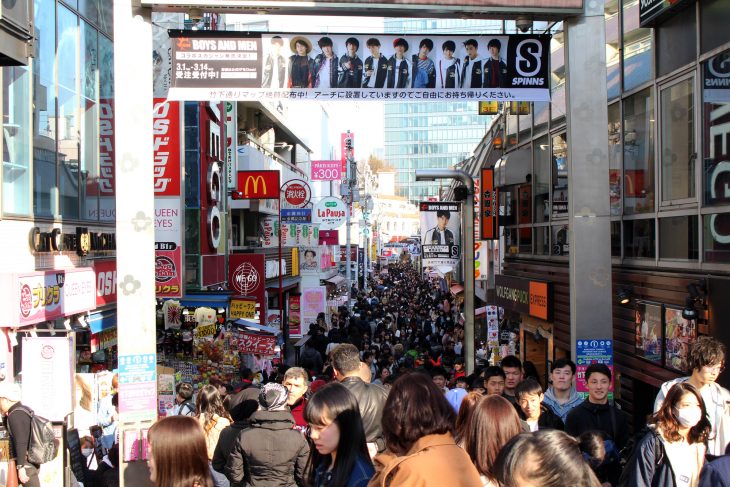
竹下通り(Takeshita dōri), the main street in Harajuku
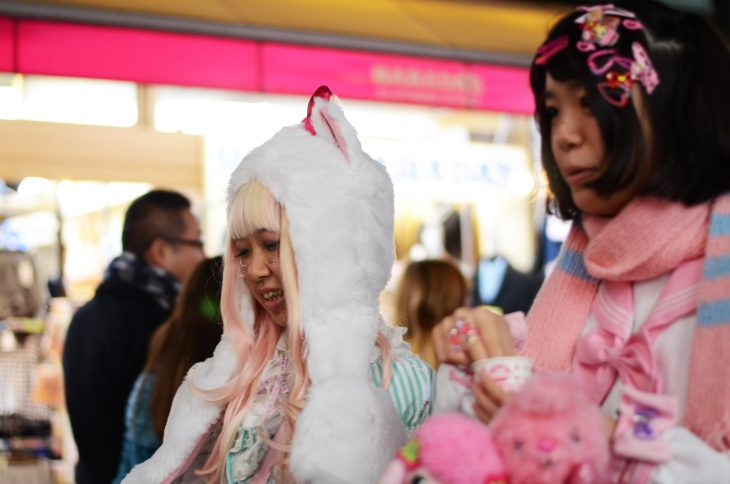
Young people in Harajuku
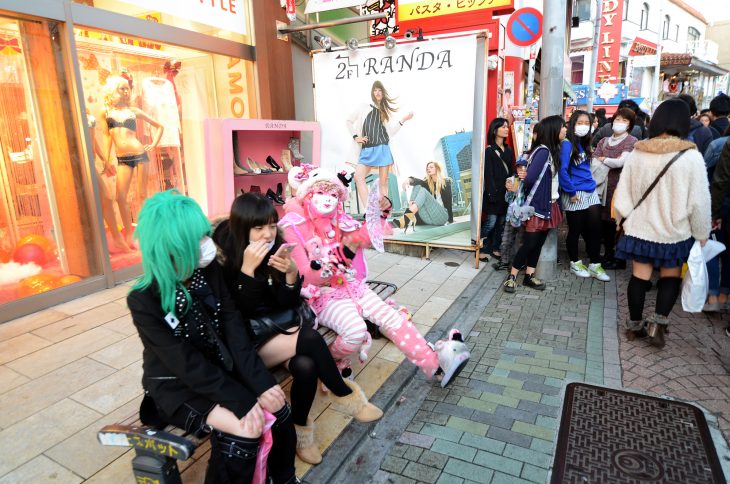
Harajuku fashion
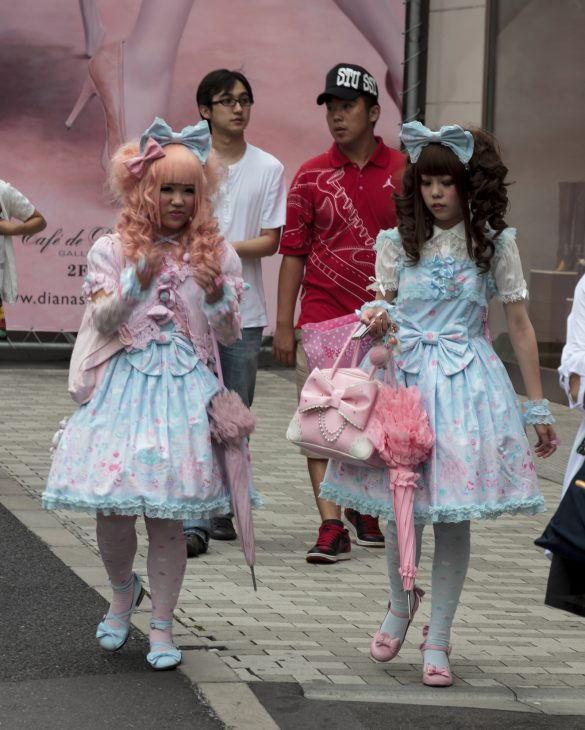
Girls are walking in Lolita fashion, a style in Japan influenced by Victorian clothing and styles from the Rococo period.
The iconic singer embodying Harajuku Kawaii culture is きゃりーぱみゅぱみゅ  (Kyarī pamyu pamyu).
(Kyarī pamyu pamyu).
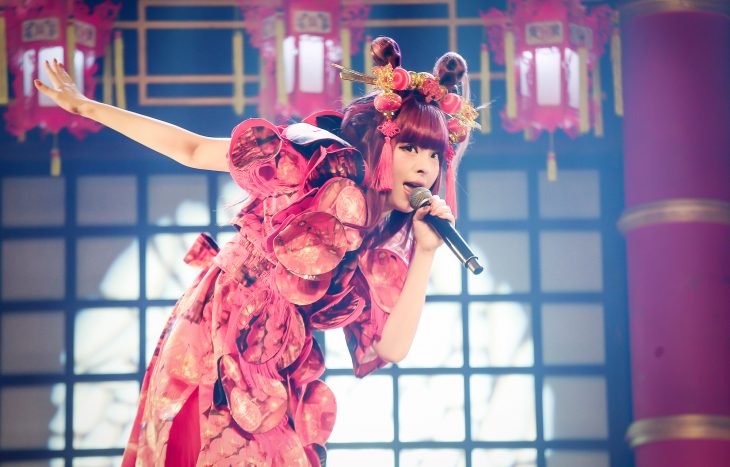
Japanese singer and model Kyary Pamyu Pamyu performs during the Kyary Pamyu Pamyu World Tour 2018 “The Spooky Obakeyashiki-Pumpkins Strike Back” concert in Shanghai, China, 28 July 2018.
This is the music video of “PONPONPON,” a song included in her very first album.
DO YOU THINK THIS IS “CUTE”? Most of the Japanese would say, “NO.”
Well, this one is her most eccentric music video. Others might be easier to accept.
The culture for these kinds of eccentric fashion is called カワイイ文化  . 文化(bunka) means culture. Some foreigners say that it looks childish and immature. Some say it is a consequence of sexism. Well, it may not look “mature” in Western culture, but I would say this is a culture for adults. Just google for a dress of Lolita fashion, and you will be astonished how expensive it is. Also, these eccentric styles are not widely accepted, and generally, it is seen “odd” even between Japanese people. You can’t expect your parents to buy these clothes unless they are sympathetic supporters. You need to work by yourself to buy them.
. 文化(bunka) means culture. Some foreigners say that it looks childish and immature. Some say it is a consequence of sexism. Well, it may not look “mature” in Western culture, but I would say this is a culture for adults. Just google for a dress of Lolita fashion, and you will be astonished how expensive it is. Also, these eccentric styles are not widely accepted, and generally, it is seen “odd” even between Japanese people. You can’t expect your parents to buy these clothes unless they are sympathetic supporters. You need to work by yourself to buy them.
Actually, those supporting “Kawaii” fashion represented by magazines such as “Zipper” or “CUTie” are mainly women. This culture has no intention to flatter men. I would rather say that the culture is about women agreeing that they look カワイイ between friends, or to value the things that you think is Kawaii regardless of what other people say.
From the fashion style centered in Harajuku to the culture of the cute characters, for example, those created by Sanrio Company, Ltd. are all described with the word “Kawaii.” The wide range of its use should be the reason why the “Kawaii” culture is spread to the world.
You may have seen this character before.
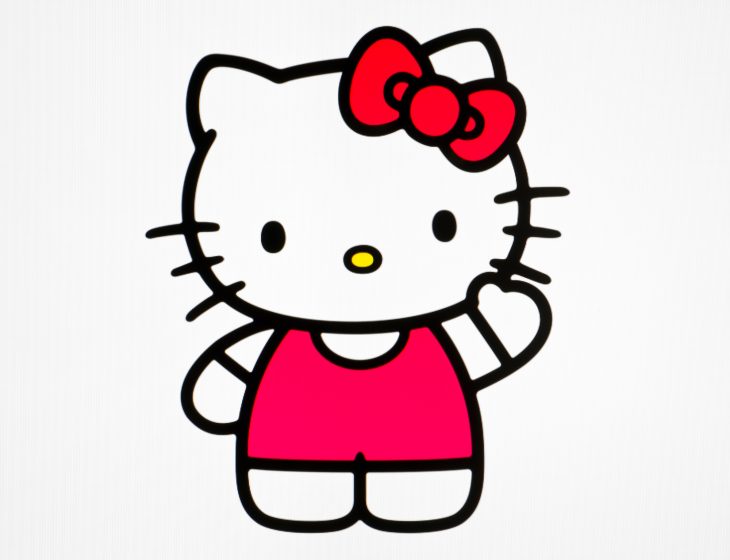
Her name is Hello Kitty(ハローキティ  , Harō Kiti). She is sometimes called キティ
, Harō Kiti). She is sometimes called キティ  (Kiti), or キティちゃん
(Kiti), or キティちゃん  (Kiti-chan). Sanrio created many kawaii characters, including her.
(Kiti-chan). Sanrio created many kawaii characters, including her.
These days, many mascot characters called ゆるキャラ  (yurukyara) are created all over Japan. They usually promote a place or region, organization, or business. The reason why ゆるキャラ is sometimes written “Yuru-chara” in English is that the term is an abbreviation for 「ゆるいマスコットキャラクター
(yurukyara) are created all over Japan. They usually promote a place or region, organization, or business. The reason why ゆるキャラ is sometimes written “Yuru-chara” in English is that the term is an abbreviation for 「ゆるいマスコットキャラクター  」, meaning “laid-back mascot characters.”
」, meaning “laid-back mascot characters.”
Probably the most famous ゆるキャラ is くまモン  (Kumamon). His job is to promote 熊(Kumamoto) prefecture.
(Kumamon). His job is to promote 熊(Kumamoto) prefecture.
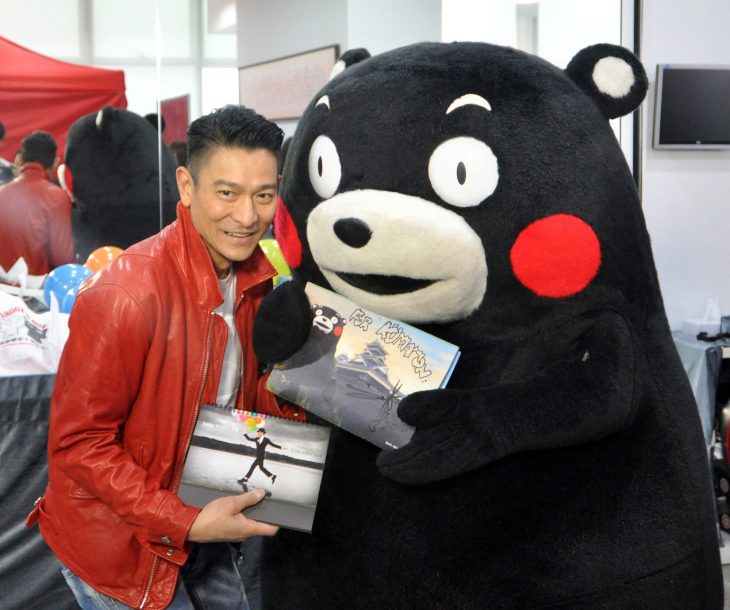
A picture of Kumamon
As explained above, ゆるキャラ is created everywhere in Japan. But some of them are described as 「キモカワ  」. 「キモカワ」is a mixture of the word 「キモい」(kimoi), which is an abbreviation for 「気持ち悪い」(kimochiwarui) meaning “gross” or “disgusting” and “Kawaii.”
」. 「キモカワ」is a mixture of the word 「キモい」(kimoi), which is an abbreviation for 「気持ち悪い」(kimochiwarui) meaning “gross” or “disgusting” and “Kawaii.”
Let’s take a look at some ゆるキャラ that are said to be キモカワ.
オハ
日曜美術館ノ時間デス
今日ノてーまハ 西洋絵画ニ見ラレル 裸婦ノぽーずツイテ デス#レルヒ団 pic.twitter.com/Yy5lv75gg3— レルヒさん (@TheodorVonLerch) July 25, 2020
レルヒさん(Reruhi-san) is a character of 新潟(Niigata) prefecture. Do you think he is kawaii…? Especially the eyes…?
皆様、本日もお疲れ様でござる
家事、育児、寝かせつけ!お疲れ様でござる。
残業の方、夜勤の方、無理のないように全ての皆様の無事を祈っておりまする。
新型コロナが終息するように祈っておりまする、用心用心でござる。
明日、2020年7月28日は火曜日でござる!
おやすいみ〜ん pic.twitter.com/9rLIGacrCV
— オカザえもん【公式アカウント】 (@okazakiemon) July 27, 2020
オカザえもん(Okazaemon) is a character of 岡崎市(Okazaki City) in 愛知(Aichi) prefecture. Hmm…a little bit of a grey area?
ふなっしー(Funasshī) is a character of 船橋市(Funabashi City) in 千葉(Chiba) prefecture. Please watch the first part of this video.
You can see that his voice and movement are gross.
Kawaii is quite a board concept.
Of course, you could say 「赤ちゃんは可愛い」( Akachan wa kawaii, babies are cute) with the usual meaning. However, when it comes to culture, it seems the concept is expanding without limit. The “Kawaii” concept is exported overseas and also changing its shape.
Akachan wa kawaii, babies are cute) with the usual meaning. However, when it comes to culture, it seems the concept is expanding without limit. The “Kawaii” concept is exported overseas and also changing its shape.
If you are interested in modern art, I recommend you reading this article. What Is Kawaii? (by Sarah Gottesman)
Maybe the person who judges whether something is “Kawaii” or not is nobody but you!
What is Onyomi?
Onyomi, also known as the "Sino-Japanese reading," is one of the two main reading systems for kanji characters in Japanese. It refers to the reading of a kanji character that is derived from the original Chinese pronunciation.
What is Kunyomi?
Kunyomi, also known as the "native Japanese reading," is one of the two main reading systems for kanji characters in Japanese. It refers to the reading of a kanji character that is based on the native Japanese pronunciation. Kunyomi readings are often used when a kanji character stands alone or is followed by hiragana, as in verbs and adjectives. Mastering both kunyomi and onyomi is crucial for understanding and using kanji effectively in the Japanese language.
What is Radical?
A radical, also known as "bushu" in Japanese, is a fundamental component of kanji characters. Radicals are the building blocks of kanji and are used to categorize and organize them in dictionaries. There are 214 traditional radicals, each with its own meaning, which often provides a clue to the meaning of the kanji character it forms.
What is strokes?
Stroke count, or "kakusuu" in Japanese, refers to the number of individual brushstrokes required to write a kanji character. Each kanji has a specific stroke order and stroke count, which are essential for writing the character correctly and legibly. Understanding and following the correct stroke order not only ensures proper balance and aesthetics but also makes writing more efficient and fluid.